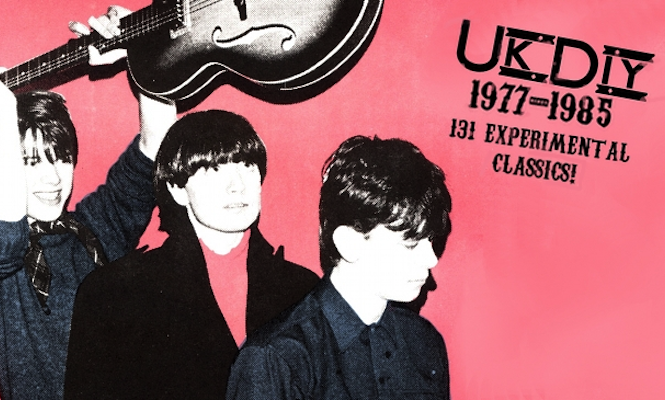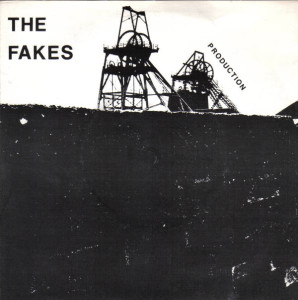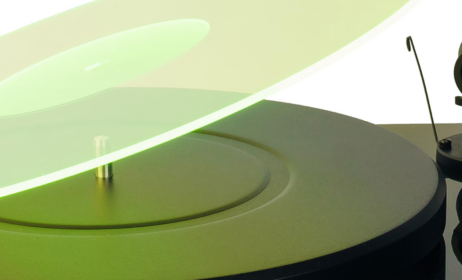Published on
October 2, 2014
Category
Features

21. DIGITAL DINOSAURS
‘Elephant Germs’
(Spott, 1980)
Beautifully klutzy stumble-pop from this great outfit, who released a batch of cassettes back in the day, on their Spott label. If this turned up in the racks now, it’d have a Siltbreeze or What’s Your Rupture label ident, for sure. There’s something in the slippery disconnect of music like this – playing that gestures toward the coathanger of song structure, but takes liberties with the pace, taking the verticality of song writing and making it horizontal – that reminds me, unexpectedly, of the staggered riffs and sensory confusion of Japanese psych-rock groups like Kousokuya. A shared aesthetic, perhaps, but one was grounded in Blue Cheer, the other in The Desperate Bicycles.
22. DISCO ZOMBIES
‘Drums Over London’
(South Circular, 1979)
Fantastic group from Leicester whose recordings were recently resurrected by Dan Selzer’s peerless Acute Records. This is from their first phase, where they were balancing the ginchy blast of punk with an articulate take on UK weirdo pop – in short, there’s something here that makes me think of a high-octane Soft Boys, but there’s also a weird edge that’s like Wire without the art school background. Neither are comparisons I thought I’d be making. I prefer this phase of Disco Zombies to their later, slightly artier music – maybe it’s that drum machine – and there’s something ‘archetypal’ about ‘Drums over London’, such that if you want to give someone a good feel for the less self-consciously experimental end of UK DIY, I’d point ‘em right here.
23. THE DISTRIBUTORS
‘T.V. Me’
(no label, 1980)
West Yorkshire represent. Dropped this one into the list because it’s such a good example of what happens when a few kids grab hold of The Normal’s ‘Warm Leatherette’ and decide they can do it too. This one has a beautiful otherness to it, an ethereal edge that belies its nervous energy: it’s all in that single-note guitar pealing through the body of the song, splitting the mechanistic bass line in two. Great drums too. This one also appeared on the Hicks From The Sticks compilation, where they shared space with Clock DVA and Section 25 (and, erm, Wah! Heat). Was Steve Beresford really a member of The Distributors for a time?
24. DOGMATIC ELEMENT
‘Strange Passion’
(The Cattle Company, 1982)
Off to Northern Ireland, where Dogmatic Element were quietly recording and performing, embracing the spaciousness of plangent bass and chiming, see-sawing guitar. This one maybe edges too close to the frosty, pre-gothic isolation of The Cure circa Seventeen Seconds, or Siouxsie & The Banshees’ Kaleidoscope, but Alison Gordon’s voice is totally arresting, corralling the Cure/Banshees damage of the music into other planes of where. Unlike a lot of UK DIY, which filled your ears with frivolity, Dogmatic Element’s music comes across as positively arctic, yet possessed of the same guileless grace as, say, The Avocadoes. This song, of course, gave the title to Cache Cache’s Strange Passion: Explorations In Irish Post Punk DIY & Electronic Music 1980-1983. A great place to start for Ireland’s early ‘80s underground.
25. DOME
‘Rolling Upon My Day’
(Dome, 1980)
After Wire fell apart, post-154, the four members of the group headed in different directions – Colin Newman started recording for 4AD and Beggars Banquet, taking Robert Gotobed with him, while Bruce Gilbert and Graham Lewis jumped off the deep end, stretching their art-school experimentation in all directions. They released some great records on 4AD, too – check out the Cupol 12”, in particular – but the four self-released Dome albums are the duo at their finest. The first Dome album hovers between blank, crudely sketched noise, ticking time bombs of experimentation, and, dropped in the midst, some gorgeous, hazy pop songs, like “Rolling Upon My Day”. The production is suitably wacked, and they seem to be pulling more inspiration from what’s happening under the radar, than Wire’s grounding in Harvest Records pre-punk prog movement. For a touch of live Dome, check this out, too:
26. DOOF
‘(Treat Me Like) The Man I Am’
(Namedrop, 1981)
I first heard about this 10” when Graham Lambkin (then of The Shadow Ring) mentioned it in an interview. It took a while to find out more, but slowly the pieces fell together – sharing membership with Twelve Cubic Feet, but seemingly the project of Philip Johnson, Doof’s sole 10” is a wildly primitive, strangely folky stumble-grunt of almost transcendental oddness. Listen to this song and redraw your understanding of exactly what The Shadow Ring were up to. Unexpectedly, many years later I discovered that one of the vocalists here was one Georgina Hartman of Marine Girls, who later went on to be in Moscovite Five and Sindy Arthur with Mark Flunder (ex-Television Personalities) – can anyone help out with tapes of either group? Thanks.
27. THE DOOR & THE WINDOW
‘D.I.Y.’
(Permanent Transcience, 1979)
Is this the theme tune for the entire movement? It should be. The Door & The Window are often held up as the ultimate DIY gang, and they certainly had mystique to burn: stories abound of the wild, protean creativity of Nag and Bendle; their connections with the London Musicians Collective and Mark Perry/Alternative TV (Perry was a member of The Door & The Window for a time); and most importantly, their ethos. which effortlessly captured that weird nexus point between post punk (as opposed to post-punk) roughness, potting-shed improvisation, and blurry, quotidian noise experiment. The liner note on their first 7”, Subculture, says it all – “Square pegs don’t fit in round holes, but open spaces are to be filled.” The Detailed Twang compilation has all you need by this wonderful and mysterious outfit.
28. RICHARD EARL
‘Intensest Weakness’
(Pilot, 1981)
Post-Swell Maps fall-out. While Nikki Sudden was losing himself in a sea of scarves, and Epic Soundtracks was recording melancholy piano figures with Robert Wyatt, Richard Earl settled in and recorded The Egg Store Ilk, one of the most anxiously warped albums to come out of ‘80s underground England. Some of the Swell Maps’ rawness is in there – particularly the strange, plodding bass runs, which ring out with a similar hollow zing to the instrumentals on their second album, Jane From Occupied Europe – but Earl adds so much metallic, percussive clatter that songs like ‘Intensest Weakness’ lose themselves in a hailstorm of cutlery and fractured glass. Why this hasn’t been reissued yet is beyond me.
29. EYELESS IN GAZA
‘Kodak Ghosts Run Amok’
(Ambivalent Scale, 1980)
Their first single, which brought them to the attention of Cherry Red, with whom they shacked up shortly after. You can hear DIY synth damage in there, for sure, but much of what made Eyeless In Gaza so alluring is also there in early form – Martyn Bates’ passionate, wide-eyed vocals, glinting, chiming electric guitar, a pulsing, wired tension (rendered here with the one-note alarm that ticks unrelentingly throughout). Later in the decade, Eyeless In Gaza would settle in to a more folkish, melancholy lilt, but here they’re anxious and tightly wound – wonderfully so.
30. THE FAKES
‘Look Out’
(Deep Cuts, 1979)
More from Scotland, this track also appeared on the Kilt By Death set – The Fakes were from Stirling and Sauchie, and this song, from their only 7”, Production, is a great example of ambition pushing a group, in the formative days of their existence, to reach for something approximating the stars. There are all kind of great details in here, from the handclaps that slice through the song like knives, to the almost modular construction of the constituent parts, drumming that sits just the right side of unkempt, and vocals that declaim and rail with insouciant spittle. It’s such a shame that they didn’t get to do more, but after the tragic death of their drummer, Brian Kemp, in late 1979, The Fakes called it a day.













